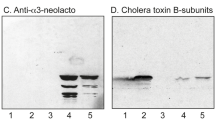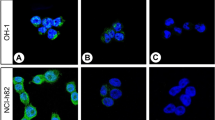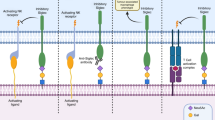Abstract
β-GLUCURONIDASE and β-N-acetylglucosaminidase both hydrolyse degradation products from chondroitin and hyaluronic acid1 and may be expected to participate in connective tissue mucoprotein catabolism in vivo. β-glucuronidase is known to show a higher activity in malignant tumours than in most normal tissues of many species and β-N-acetylglucosaminidase has a similar pattern of distribution of activity2. The activities of both these glycosidases in transplantable experimental tumours in mice are much higher in solid, invasive, subcutaneous tumours than in non-invading but otherwise similar tumour cells growing in the peritoneal cavity3.
This is a preview of subscription content, access via your institution
Access options
Subscribe to this journal
Receive 51 print issues and online access
$199.00 per year
only $3.90 per issue
Buy this article
- Purchase on Springer Link
- Instant access to full article PDF
Prices may be subject to local taxes which are calculated during checkout
Similar content being viewed by others
References
Linker, A., Meyer, K., and Weissman, B., J. Biol. Chem., 213, 237 (1955).
Conchie, J., Findlay, J., and Levvy, G. A., Biochem. J., 71, 318 (1959).
Carr, A. J. (in the press).
Conchie, J., and Levvy, G. A., Biochem. J., 65, 389 (1957).
Findlay, J., Levvy, G. A., and Marsh, C. A., Biochem. J., 69, 467 (1958).
Author information
Authors and Affiliations
Rights and permissions
About this article
Cite this article
CARR, A. Effect of Some Glycosidase Inhibitors on Experimental Tumours in the Mouse. Nature 198, 1104–1105 (1963). https://doi.org/10.1038/1981104a0
Issue Date:
DOI: https://doi.org/10.1038/1981104a0
This article is cited by
-
Expression of PCNA, AKP and ACP during development of mouse fore stomach carcinoma
Chinese Journal of Cancer Research (2006)
-
Glycosidases in cancer and invasion
CANCER AND METASTASIS REVIEW (1985)
-
Einflu� des Vitamin A auf die MNNG-induziert Cancerogenese im Dr�senmagen der Ratte
Langenbecks Archiv f�r Chirurgie (1983)
-
Serum activities of lysosomal enzymes in patients with liver cell carcinoma
Digestive Diseases and Sciences (1982)
Comments
By submitting a comment you agree to abide by our Terms and Community Guidelines. If you find something abusive or that does not comply with our terms or guidelines please flag it as inappropriate.



